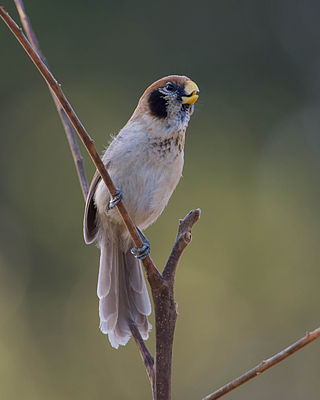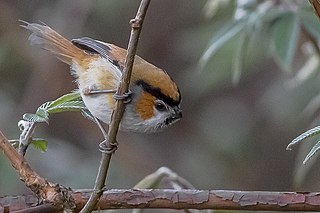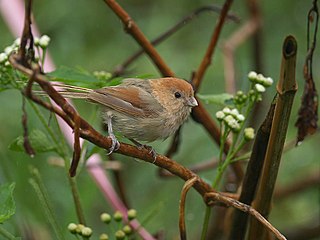
The parrotbills are a family, Paradoxornithidae, of passerine birds that are primarily native to East, Southeast and South Asia, with a single species in western North America, though feral populations exist elsewhere. They are generally small birds that inhabit reedbeds, forests and similar habitats. The traditional parrotbills feed mainly on seeds, e.g. of grasses, to which their robust bill, as the name implies, is well-adapted. Members of the family are usually non-migratory.

The bearded reedling is a small, long-tailed passerine bird found in reed beds near water in the temperate zone of Eurasia. It is frequently known as the bearded tit or the bearded parrotbill, as it historically was believed to be closely related to tits or parrotbills. Today it is known to lack close relatives and it is the only species in the family Panuridae.

The ashy-throated parrotbill is a parrotbill. In old sources, it may be called Alphonse's crow-tit; though superficially resembling a tit it is not a member of the Paridae. The native range of this species extends from south-west China to northern Vietnam, and it might have become naturalised in one area in Italy.

Jerdon's babbler is a passerine bird native to wetlands and grasslands of the Indian sub-continent. It is listed as Vulnerable on the IUCN Red List since 1994. It is a member of the genus Chrysomma of the family Paradoxornithidae.

The black-breasted parrotbill is a 19 cm long, large, thick-billed parrotbill with black patches on the head-sides and throat. Formerly placed with the typical warblers in the Sylviidae, the parrotbills are now considered a distinct family, the Paradoxornithidae.

The great parrotbill is a bird species the Paradoxornithidae family. It is found in Bhutan, China, India, Myanmar, and Nepal. It was previously placed in a monotypic genus, the Conostoma.

The fulvous parrotbill is a species of parrotbill in the family Paradoxornithidae. The species is also known as the fulvous-fronted parrotbill, the fulvous-fronted suthora, and the fulvous-fronted crowtit. The species, along with several others from the genus Suthora, is sometimes placed in the genus Paradoxornis. The species has four subspecies; the nominate subspecies from central Nepal, Bhutan and north-east India; P. f. chayulensis from north India and south China; P. f. albifacies from north Burma and nearby south China, and P. f. cyanophrys from central China.

The grey-headed parrotbill is a parrotbill in the family Sylviidae and is found in eastern Asia from the Himalayas to Indochina and Hainan.

The spot-breasted parrotbill is a species of bird in the family Paradoxornithidae. It is found in Bangladesh, China, India, Laos, Myanmar, Thailand, and Vietnam.

The black-throated parrotbill is a parrotbill species often placed with the Old World babblers or in a distinct family Sylviidae, but it actually seems to belong to the distinct family Paradoxornithidae.

The three-toed parrotbill is a species of parrotbill in the family Paradoxornithidae. It is endemic to central China. Its natural habitat is temperate forests.

Przevalski's parrotbill or the rusty-throated parrotbill, is a species of parrotbill in the family Paradoxornithidae. It is endemic to a small area of central China. Its natural habitat is temperate forests. It is threatened by habitat loss.

The rufous-headed parrotbill, or greater rufous-headed parrotbill, is a parrotbill in the family Paradoxornithidae and is found in eastern Asia from the eastern Himalayas to Indochina.

The brown parrotbill is a parrotbill found in the central and eastern Himalayas. It is also known as the brown suthora. This is a 17–19 cm (6.7–7.5 in) long grey-brown bird with a long tail and a characteristic small, yellowish, parrot-like bill. A dark stripe runs above the eyes and along the sides of the crown. The bird moves in small groups and will sometimes join mixed species foraging flocks. It is found in Bhutan, China, India, Myanmar, and Nepal.

The golden parrotbill is a species of parrotbill in the family Sylviidae. It is found in China, Laos, Japan, Myanmar, Taiwan, and Vietnam. Its natural habitat is subtropical or tropical moist montane forests.

The vinous-throated parrotbill is a species of parrotbill in the family Paradoxornithidae; formerly, it was placed in the closely related Sylviidae or Timaliidae. It is found in China, Japan, Korea, Mongolia, Russia, Taiwan, and Vietnam. Its natural habitat is subtropical or tropical moist montane forests.

The grey-hooded parrotbill is a species of parrotbill in the family Paradoxornithidae. It is endemic to China. Its natural habitats are temperate forests and temperate shrubland. It is threatened by habitat loss.
The Yunnan parrotbill is a parrotbill in the Old World babbler family. This 10 cm long parrotbill is endemic to China, breeding in northwest Yunnan.

The white-breasted parrotbill is a bird species often placed with the Old World babblers or in a distinct family Paradoxornithidae, but it actually seems to belong to the Sylviidae.
The black-headed parrotbill is a bird species often placed with the Old World babblers or in the Sylviidae, but it actually seems to belong to the distinct family Paradoxornithidae.




















